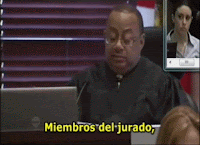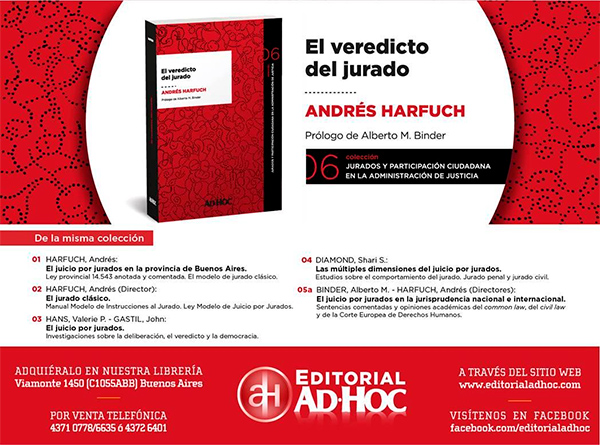The jury decided, in a marathon session, that Ariel Gimenez was the perpetrator of serious injuries.
From now on, when the jury system is chosen, both prosecutors and defenders will need to use, more than ever, their power of seduction. Forensic terminology, jargon and gadgetry of law would no longer help the lawyers in front of the 12 citizens in charge of defining the guilt or innocence of the defendant.
Yesterday in Junín, the system made its debut with a judgement that was situated in the middle of what was requested by the parties, since despite having found the defendant guilty, it was for the lesser included offense of those requested by the prosecutor Silvia Ermacora.
After nearly 10 hours of trial (started just after 11 am and ended minutes before midnight), the 12 selected jurors -from a poll of 48 that, actually was of 35, because some of them excuse themselves from jury duty- determined that Ariel Gimenez, 22 years old, be convicted of the crime of “assault with serious bodily harm» inflicted on Ivan Sarrachini, on May 13 last year in the town of Vedia.
The prosecutor charged Gimenez with «attempt of murder», an offense which imposed a eavier sentence for this young bricklayer, who arrived to the trial with house arrest and a permission to work during the day.
For its part, the public defender, Gerardo Doyle, based his hypothesis on the fact that Gimenez acted under self-defense, as he responded to an attack by Sarrachini, that is why after hearing that the verdict was for the lesser included charge of assault, he requested the immediate waiver of imprisonment for his client, since the law permits to do so. Given this, the prosecutor objected, and the trial judge, Miguel Angel Vilaseca, postponed that ruling for today.
Minutes after midnight, the accused returned to his home in Vedia in the same way he arrived: in a patrol car, and he will also have to wait for a decision regarding his status as «imprisoned».
The feeling inside the courtroom was that the verdict rendered by the jury was the one that permitted to choose a middle term between both positions. If the prosecutor would not have requested that if not found guilty of «attempt of murder», the defendant shall be charged with “assault”, the decision should have been in favor of the accused.
There were more reasonable doubts on the testimonies heard, than facts proved by the prosecutor and her team.
A key point in this «reasonable doubt» was the actions of the accused after the assault. Instead of escaping from the crime scene and not taking responsibility, he not only showed up voluntarily in the local police station, but also went to the Vedia hospital to give notice of what happened to Sarrachini seeking for immediate assistance.
This attitude is not consistent with someone who wants to kill another person. For the prosecution, that only happened because Giménez realized what had happened and acted that way so to avoid facing worse consequences.
Doubts on the victim
Sarrachini gave testimony yesterday and his words brought more confusion to what really happened. Not only had he remembered nothing of what had happened that day after noon, but also said that the last thing he remember is having left the house at Belgrano Street and waking up at the Hospital. In addition, his timeline did not match the timelines of the witnesses of the fact.
According to the testimonies of the two women who lived at that address, Silvia Villareal (the defendant girlfriend at that time) and Graciela Dominguez, Serrachini kept a strange and violent relationship with them.
Serrachini, who do not charge these women any rent, behaved as a «feudal lord» that made women this favor of a «free» housing, as long as the two women did not have romantic relationships with other people. Apparently, the man was jealous and treated them as if they were his property.
That is why this man could not explain why he went in and out of the house in several occasions saying that he entered there to drink “mate” and that he always asked for permission first to get in and that he remained there only for a few minutes.
The women said that a month before the fact, Serrachini threatened both with a «carbine» and said he did not want other men there. Allegedly, that day he also threatened one of Villarreal daughters, «he put the gun on her head,» she said.
The women pressed no charges, alleging they did not consider him as a threat. The fact that they lived in his place paying no rent and that the two had young children, can lead us to assume that they were afraid of accusing him for fear of being thrown out of the place.
For the prosecutor, that hypothesis was discarded because it has been proved that the two women, one of them recently moved out, lived in the place until today, regardless of what happened and that in trial both were going to testify on behalf of Gimenez.
During the trial it was alleged that Serrachini intended to exchange this “rent free” for sexual favors from these women, and he got jealous if they were with other men and not with him. Presumably, this would have been the reason for the rivalry and bitterness with Gimenez.
Saying to Gimenez in several opportunities that he did not want to see him there. In the day of the events, there was a discussion among these men. According to the defendant, before what happened, Sarrachini threatened him with a rifle (which was not found at the scene of the crime), and that’s why he went home to see if he could take his partner and her four children there.
When he returned an hour later along with a cousin, in order to take them with him, the fight that could end in tragedy precipitated.
The victim could not specify the time in which he was in the house, or what happened next. There were lots of doubts after his testimony.
For its part, the defendant said that he reacted only when Sarrachini tried to hit him, and that he was “unleashed “by the situation that had arisen.
For the jury, Gimenez´guilt was framed in the result of the punches that Sarrachini suffered, as he arrived to the Hospital in a coma and critical condition after being treated at Vedia Hospital. He remained hospitalized just a few days, since the scans showed no neurological damage and his health evolved favorably.
Doubts and learning on the go
Yesterday trial was the kind of trial that had rarely been covered by the media and that would not have lasted more than half a day, if it was developed in front of a bench judges. But the fact that this was the first jury trial in this Judicial Department, aroused the curiosity of many people, the questions of how to perform it and certain logic delays of the situation.
Apart from the common delays in trials, there was also time dedicated to the instructions that Judge Vilaseca gave to the jury (the 12 seated jurors and 6 alternates).
Before entering the room on the sixth floor, reporters also had to sign a document agreeing not to hinder the process.
After jurors had been selected, the defense lawyer noted that there were seated seven men and five women, when the law specifically states that the jury must be composed by six men and six women.
That generated some doubts that were resolved within minutes, passing one of the alternate women in place of one of the men.
At the end, the judge gave further instructions to the jury on how they should conduct when deciding guilt or innocence.
Despite the delays that the process had, there were several long recesses; the jury verdict did not take more than 30 minutes.
Judge Vilaseca acknowledged at the end, when the clock already marked midnight, that maybe his intends to finish the trial in one day were wrong, but all jurors agreed to continue, since some of them had to travel very far.








